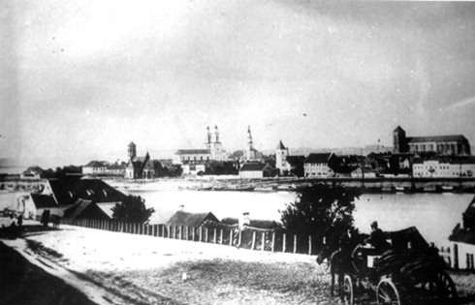 |
| #1..Kaunas 1890s Boris
Feldblyum Photographic Collection |
Kovno Also known as: Kaunas (Lithuanian)
Kovna, Kovne Location: At the confluence of the Neiman (Nemunas)
and Neris rivers, 100 km west of Vilna (Vilnius).
Historically the second city of Lithuania, and its capital
from 1918-1940. Under Czarist Russian rule, it was the provincial
capital, administrative seat for much of central Lithuania,
then known as Kovno guberniya.
Many of our ancestors migrated from Vilkomir to Kaunas in
the latter half of the 19th century.
Jews were engaged in trade in Kaunas in the 16th century,
but due to opposition from Christian merchants, they were
prohibited from the city on numerous occasions. The ban existed
until the 18th century when Jews were permitted to settle
on two streets in Kaunas and to engage in trade. They were
expelled again in 1753 and 1761 when there were anti-Jewish
riots. The Jews found refuge in Slobodka, on the other side
of the Viliya River, where a Jewish settlement had existed
long before that of Kaunas. In 1782 the expelled Jews were
permitted to return to Kaunas.
After the partition of Poland in 1795, Kaunas became part
of Russia. In 1847 there were 2,013 Jews living in Kaunas
and Slobodka, 16,540 in 1864, 25,441 in 1897 (30% of the population)
and 32,628 in 1908 (40% of the population.) From the second
half of the 19th century, Kaunas became a center of Jewish
cultural activity in Lithuania.
In May 1915 an edict was issued by the czarist government
expelling the Jews from the entire province. When later the
city was occupied by the Germans, about 9000 Jews returned,
and communal life was revived with the help of Jews in Germany.
During W.W.II, after the outbreak of the German Soviet war
and even before the Germans occupied Kaunas (June 24, 1941,)
Jews were killed there by Lithuanian Fascists. Immediately
after the German occupation, large scale anti-Jewish pogroms
took place affecting some 35,000 Jews. The Jews in both Slobodka
and Kaunas were moved into the ghettos.
By the end of 1941, the Jewish underground, operating in the
ghetto numbered 800 members. They began sending people into
the forests to join the partisan resistance against the Germans.
Through lack of experience and the hostility of the local
population, many members of the underground were killed or
captured.
When the Soviet attack began in July, 1944, the Germans liquidated
the Kaunas ghetto and concentration camps camps in the area,
using grenades and explosives to kill the Jews. In this action,
some 8000 Jews and others were sent to Germany. The men were
sent to Dachau and the women to Stutthof. Over 80% of them
died in these camps before liberation.
Kaunas was taken by Soviet forces on August 1, 1944. Most
of the Jewish survivors did not return to Lithuania. Many
settled in Israel.
Please read Peter Geffens description of
his 2004 summer trip to Kovno, Vilna, Slobodka and The 9th
Fort. Click
here. |









